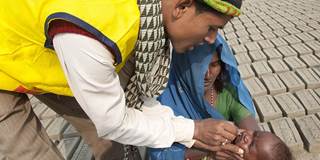Pharmaceutical companies are not charities. If we want them to make vaccines and treatments that will help the poor in developing countries, we need to find ways of giving them – and their shareholders – a return on their investment.
PRINCETON – The deadly outbreak of Ebola in Liberia, Sierra Leone, and Guinea that began last year highlighted a problem in the production of pharmaceuticals. Once it became clear that the epidemic would not be rapidly contained, several firms quickly arranged for clinical trials of potential treatments and vaccines, indicating that they already had the ability to produce plausible candidates.
Ebola is not a new disease: it was first identified in 1976. Prior to 2014, however, the largest outbreak was in Uganda, in 2000, when 425 people were infected and 224 died. Though Ebola was known to be both contagious and often fatal, it was thought that only Africa’s impoverished rural population was at risk. For pharmaceutical firms, the development of a vaccine or treatment was not commercially attractive, and so it did not warrant investment.
All that changed with the latest outbreak. In September 2014, the United States Centers for Disease Control and Prevention predicted that, in the worst case, 1.4 million people could be infected within four months. Media-fed fears that the disease could spread to affluent countries led to extraordinary precautions. In the United States, President Barack Obama asked Congress for $6.2 billion, including $2.4 billion to reduce the risk of the disease becoming established in America and set up 50 US Ebola treatment centers.

PRINCETON – The deadly outbreak of Ebola in Liberia, Sierra Leone, and Guinea that began last year highlighted a problem in the production of pharmaceuticals. Once it became clear that the epidemic would not be rapidly contained, several firms quickly arranged for clinical trials of potential treatments and vaccines, indicating that they already had the ability to produce plausible candidates.
Ebola is not a new disease: it was first identified in 1976. Prior to 2014, however, the largest outbreak was in Uganda, in 2000, when 425 people were infected and 224 died. Though Ebola was known to be both contagious and often fatal, it was thought that only Africa’s impoverished rural population was at risk. For pharmaceutical firms, the development of a vaccine or treatment was not commercially attractive, and so it did not warrant investment.
All that changed with the latest outbreak. In September 2014, the United States Centers for Disease Control and Prevention predicted that, in the worst case, 1.4 million people could be infected within four months. Media-fed fears that the disease could spread to affluent countries led to extraordinary precautions. In the United States, President Barack Obama asked Congress for $6.2 billion, including $2.4 billion to reduce the risk of the disease becoming established in America and set up 50 US Ebola treatment centers.